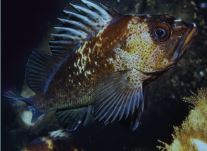Rockfish Conservation Areas: You can protect British Columbia’s tiger and other inshore rockfish
Inshore rockfish species live on rocky and glass sponge reefs, do not swim far from their home reefs, and many can live over 100 years! They are very susceptible to overfishing.
Rockfish Conservation Areas (RCAs) help protect declining populations of British Columbia’s inshore rockfish species from fishing mortality.
Most fishing activities, including recreational halibut and salmon fishing, are prohibited in all 162 RCAs. The only permitted fishing activities are:
Recreational
- Crab, shrimp and prawn by trap
- Invertebrates by hand picking or dive
- Smelt by gillnet
Indigenous Peoples’ Food, Social, and Ceremonial (FSC)
- Harvest and conservation decisions made by Indigenous governing bodies within FSC allocations
Commercial
- Crab, shrimp and prawn by trap
- Euphausiid (krill) by mid-water trawl
- Groundfish by mid-water trawl
- Herring by gillnet, seine, and spawn-on-kelp
- Invertebrates by hand picking or dive
- Salmon by seine or gillnet
- Sardine by gillnet, seine, and trap
- Scallop by trawl
- Smelt by gillnet
Protecting fragile habitat
Some RCAs overlap with Glass Sponge Reef Conservation Areas that prohibit all bottom contact fishing activities (including prawn, shrimp and crab fishing). Fishing gear and boat anchors can destroy these fragile rockfish habitats. To learn more visit: Canada.ca/glass-sponge-closures
Inshore rockfish species
| Rockfish | About |
|---|---|

Yelloweye Rockfish |
Up to 91 cm. Yellow-orange to orangey-red to dark red with bright yellow eyes. Juveniles red with 2 light stripes. |

Quillback Rockfish |
Up to 64 cm. Dark brown to black speckled with pale areas on the head and below the high, spiny, and deeply notched dorsal fin. Freckles on head and/or throat, particularly as juveniles. |

Copper Rockfish |
Up to 66 cm. Brown to copper with pink or yellow blotches. Pale stripe along lateral line on the last 2/3 of the body. |

China Rockfish |
Up to 45 cm. Black body, speckled with yellow and white. Yellow stripe down dorsal fin and back along the lateral line. |

Tiger Rockfish |
Up to 61 cm. Pink, white to brownish-red body with 5 dark red or black vertical bands and 2 bands radiating from eyes. |

Black Rockfish |
Up to 69 cm. Bluish-black, elongated body with black speckles, a white or grey belly and white or grey blotches between the dorsal fin and the lateral line. |
Interesting facts about rockfish and rockfish conservation areas
- Many species of rockfish are slow-growing and extremely long-lived; Yelloweye and Quillback can reach 115 and 95 years, respectively.
- Inshore rockfish stocks are at low levels in British Columbia.
- Older females are critical to rockfish population recovery because they produce the most larvae.
- Unlike salmon, rockfish have closed swim bladders and usually do not survive after catch and release. They can’t adjust to rapid pressure changes when they are brought to the surface.
- RCAs were established to protect a portion of inshore rockfish populations, including Yelloweye, Quillback, Tiger, China, Copper, and Black Rockfish, from fishing mortality.
- The 162 RCAs located along BC’s coast cover approximately 4,800 km2 of inshore habitat, including rocky and glass sponge reefs, kelp forests, and eelgrass beds.
Related materials
- Date modified: